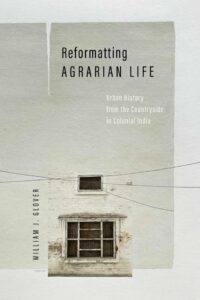Cities and villages are not binaries but exist on a continuum. In Reformatting Agrarian Pasts: Urban History from the Countryside in Colonial India, urban historian William J Glover traces the events and infrastructure projects that intertwine rural and urban spaces through specific administrative policies formulated and implemented by the British government. For Glover, the importance of this history lies in the way the interconnection has continued for contemporary India: India is no longer an agricultural economy the way it has traditionally been understood. As the latest census of India shows, urbanization has gradually left Indian cities and come to occupy rural spaces, making villages more city-like along with losing their rootedness in traditional occupations. After the “interventions” by the officials—such as menial labour as construction sites in exchange for food relief, concepts of urban planning, changes in pedagogy, and bringing about cosmetic changes to the countryside — rural spaces were rendered hollow.

Using Punjab as a site of investigation, Glover points to four phenomena between the late 19th and mid-20th centuries that can be linked to the increasing inter-dependence between urbanism and rurality. The first was set in motion by the 1880 report by the Royal Commission on Famine. As per its Famine Code for India, relief for famine involved:
Government provision of survival-wage remuneration for labor on public works for the able-bodied, supplemented by “gratuitous” assistance to the demonstrably unemployable. Food would be procured strictly through the open market, a strategy encouraged in part by the anticipated extension (at the time) of transport networks, particularly railways. Wherever grain was more plentiful, the government’s primary obligation was to make it “available, wherever and wherever it is needed, by extended railway communication, through the agency of the natural trade of the country.”
Thus, cities and migration to cities came to be involved in rural governance as opposed to the village-specific famine relief work that was practised earlier. One consequence of this shift from relief to labor was that agriculture and allied vocations came to be governed by “market logics” or “market instruments” involving railways and commission agents which were rooted in urban milieu.
The second phenomenon was canal colonization of Punjab, an infrastructural project that began in 1892 and was concluded in 1930. The project involved conversion of land into canal-irrigated rectangular estates, proprietary in nature, to cultivators from elsewhere to exert greater control over the land and make it yield greater produce and thereby revenue.
With few preexisting proprietary estates to accommodate, and government control over all other land, Punjab’s canal colonies entailed reformatting an entire landscape. Not only were fields, villages, towns, roads, and rail routes now all described by shared, simple geometries, but newly settled estates in the colonies also gave the colonial state an opportunity to control proprietary relations and even establish new customary practices (including in some cases, rules of inheritance) from scratch.
The making of the estates in the image of cities invited other urban problems such as the building of slums and construction of unauthorised bazaars adding informality to the spaces. Villages, in other words, became citified.
The designing of agricultural education to stop village to city migration was the third phenomenon. The British tried “to extend urban values into rural areas while simultaneously working to reinscribe rurality with a distinctive and desirable character.” However, the plan did not work as intended. Instead of equipping students to work within agriculture in more informed ways, the degree made them feel entitled to administrative jobs, thus further removing them from rural living.
In an attempt to reverse the trend of attraction among the rural youth to urban life, the British government began to invest in the rural uplift or reconstruction projects. An example of this fourth phenomenon was the rural uplift project by Frank Lugard Brayne, Gurgaon’s district commissioner. Brayne’s “Gurgaon Experiment” involved, in the words of his contemporary Malcolm Darling who assessed the project:
[Brayne’s] method was to “take the whole district as the field of operations, and to deluge the area with every form of propaganda and publicity that we could devise or adopt or afford.” The great ally was the magic lantern and after that parties of strolling minstrels and glee singers “roped in and bribed to sing our ‘dope.’ They cost very little and hundreds of villagers will sit enthralled for hours while they tell them in song how to wash the baby, or what sort of wheat to sow!” Finally, “we plaster the walls with cartoons and posters, distribute leaflets, handbills, and poems, and organise shows and demonstrations and competitions … and prizes are even given for poems and essays.” In a word the method was propaganda, more propaganda, and still more propaganda.
The very little “uplift” work involved was that of manual labour that the villagers were forced to undertake: digging manure pits, repairing roads and pond banks, and organising clean-up drives. Eight years later, the Gurgaon district board was bankrupt.
Glover’s method of doing urban history from the village by tracing where and how cities are mentioned in archives is a significant contribution to contemporary understanding of thinking beyond contemporary framing of Punjab as the wheat basket of India or granary of India. It shows the ways in which the rural and the urban intersected because of the meddling by the officials of the British government. Their policies continued to be followed by the authorities post-Independence through means such as spatial planning, distribution networks for agricultural produce, and focused efforts towards building of agro-industrial townships. Postcolonial India continues to be haunted by the decisions made more than a 100 years ago.


You must be logged in to post a comment.